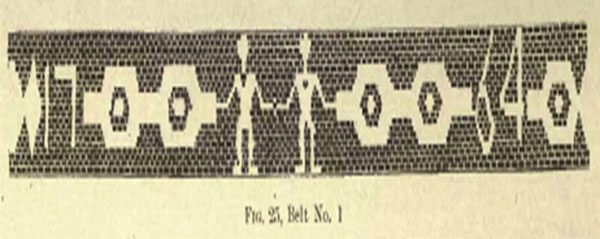 |
 |
 |
Photographs (left to right): Spider, Florida; Armadillo, Florida; Ducks on a Log; Seattle, Washington
Wampum Belt Archive
1764 Treaty of Niagara Covenant Chain Belt

Original Drawing of the Fort Niagara Belt (Hallen, 1852)

Reproduction (R. D. Hamell) Nov. 16 2010
Original Size: |
Length: not given. Width: not given. Rows: 22 wide by 458 rows long. |
Reproduction: |
Beaded Length: 80 inches. Width: 10 inches. Total length with fringe: 104 inches. |
Beads: |
Rows: 22 wide by 458 long. Total 10,076. |
Materials: |
Warp: Leather. Weave: Artificial Sinew. |
Description (Wikipedia):
The 1764 Treaty of Fort Niagara was signed by Sir William Johnson for The Crown and 24 Nations from the Six Nations, Seneca, Wyandot of Detroit, Menominee, Algonquin, Nipissing, Ojibwa, Mississaugas, and others who were part of the Seven Nations of Canada and the Western Lakes Confederacy. The Treaty was concluded on August 1, 1764. The treaty transferred possession of a narrow four mile strip of land along the Niagara River's western shore. This treaty also detached some of them from Pontiac's Rebellion.
The Royal Proclamation of 1763 established the British definition of Indian Country. On these lands The Crown claimed sovereignty but it also decreed that Indian Country were to be considered the possession of the Aboriginal peoples who lived on these lands. Consequently, in order to transfer ownership of the land to The Crown through the surrendering of the land from the indigenous peoples, the British Crown began formalizing the Treaty of Fort Niagara with the First Nations on July 8, 1764, through this Treaty Council. In protest, the Odawa of Detroit, the Wyandot of Sandusky, and the Lenape and Shawnee of the Ohio failed to come to the Treaty Council. This treaty created a new Covenant Chain between Britain and the First Nations of the western Great Lakes. During the War of 1812, Nations involved with this treaty allied themselves with the British, as the Nations believed the treaty bound them to the British cause.
The Ontario Archaeological Report of 1901 described this belt:
Figure 25. This belt consists of 22 strings or strands, each string containing 458 beads, or a total of a little more than ten thousand beads (10,076). The human figures, with hands clasped indicate that a treaty is in force. The hexagonal figures doubtless symbolize national council fires. The belt contains the date 1764, woven in two parts "17" and "64" in the wampum beads, like an old-fashioned sampler. Just after the Pontiac war, deputies and warriors from many tribes assembled at Niagara in July, 1764.
Amongst them was a band of Ottawas from Michiliinackinac, and it was doubtless to these that the belt was then given by Sir Wm. Johnson, whose name was written on the drawing by Mr. Hallen, who had also penciled on the margin of the paper the following particulars of the ends of the belt: "The leathers are not above from half an inch to two inches long at the beginning, but half an inch to one inch at the ending. There are six branches of beads at the beginning, containing altogether 192 beads. One of the leathers is tied to the belt with a violet or blue ribbon Number of beads, in each branch, 6 July, 1852; 20, 35, 38, 40, 30, 29; total, 192."
See the Annual Presents Belt (24 Nations) for additional information.
Anishinabek Confederacy
The 1764 Treaty of Fort Niagara: The 1764 Treaty of Fort Niagara is an agreement that establishes our alliance with the British Crown where the Canadian State is its current Representative. In this Agreement the Crown offered us the Great Lakes Covenant Chain Confederacy Belt and The Twenty Four Nations Belt where we as those Twenty Four Nations accepted and exchanged with the Crown the Two Row Wampum Belt. By agreeing to this our Nations and the Crown accepted a nation-to-nation relationship rooted in a policy of peace and non-interference. These Belts also serve as the first constitutional documents for the Canadian State and any breach of this agreement is a disengagement of the Canada’s validity as a Country within our territories making all other laws of theirs invalid.
Maurice Switzer
According to Switzer (2017) the five links in the Covenant Chain might refer to council fire locations, details about which I'm not specifically knowledgeable. Alan Corbiere and other researchers have speculated that the inner beadwork of the links may be references to the Dish with One Spoon Belt, to which they bear some resemblance. However, Switzer adds, while some individuals are speculating if there are a geographic meaning to them.
The Union of Ontario Indians contracted some Shawnee women in Tecumseh territory (Greenville, Ohio) to make a copy of the Niagara belt from real wampum beads.
They had created an actual-sized paper template and , one day, when they had left it on a table, it curled into a circle, and the diamond segments fit perfectly! Which I interpret as signifying that the agreement has no end, no time limit. A complete circle also speaks to unity.
A similar alignment of the Canandaigua Treaty (Washington) Belt had been suggested.
Onondaga Records
At least 84 wampum belts were exchanged.
Author's Note:
This belt was a challenge to make. The original belt had been reported lost in a fire during the turn of the 20th Century. The length and wide of the belt can be estimated by its bead length (458) and bead width (22). Using a graphic program (CorelDraw) the image was enlarged to 11 inches. Therefore, each bead width would be 0.024 inches. The next step was to overlay a grid using the bead width to determine each figure's bead count and the bead spacing between each figure. Once that was completed the bead count was compared to the original belt length. Due to the resolution of the original photocopy of the treaty belt there may be some error in the reconstruction of the images. Secondly, the using on the modern acrylic-clay wampum might have increased the length and width of reproduction from the original. But I feel confident the replica belt a relatively accurate representative of the Niagara Treaty Belt of 1764.
Belt kept by Odawa Chief Assekiknk (Blackbird) in 1852. Drawing by Rev. Hallen.
Reference:
Anishinabek Confederacy: http://oshkimaadziig.org/governing-laws/
Switzer, Maurice. Director of communications for the Union of Ontario Indians provided the images for the 24 Nations and the Niagara Treaty (1764) belts.
Wikipedia: http://en.wikipedia.org/wiki/Treaty_of_Fort_Niagara
 |
 |
 |
 |
 |
 |
 |
 |
|---|